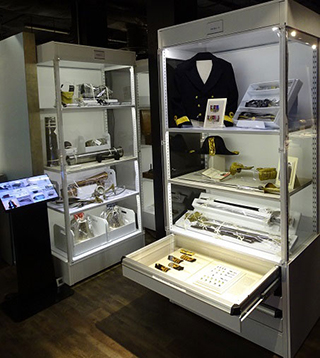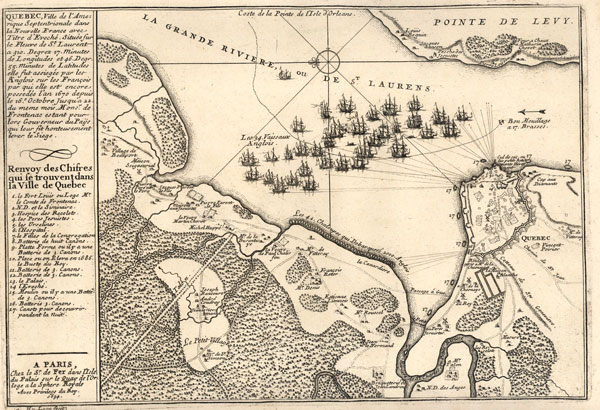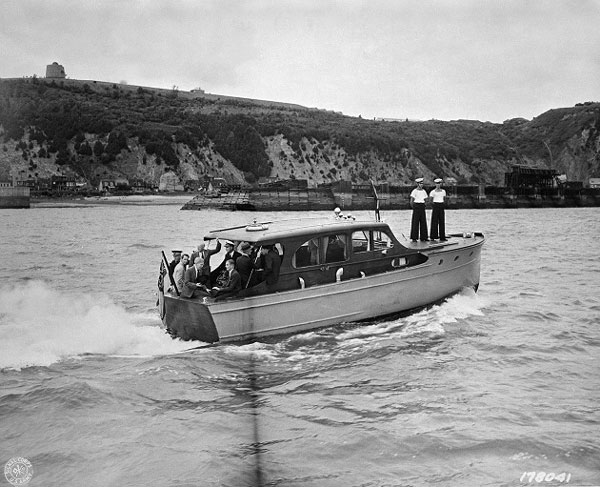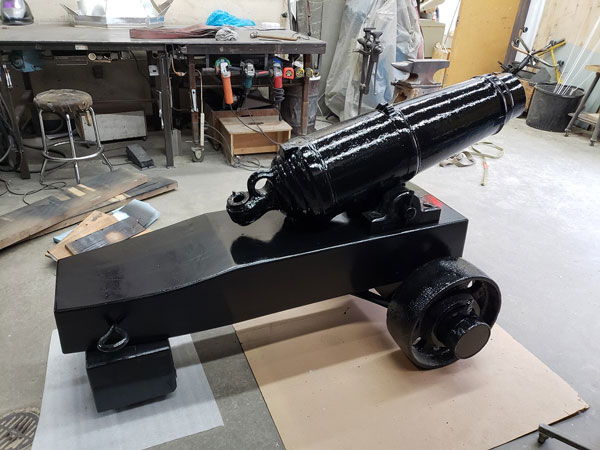Naval Museum of Québec

Introduction

Caption
Bow of the French ship of the line Le Protecteur, a model made by Hubert Lavoie.
Strongly moored in Quebec and Canadian naval history, the Naval Museum of Québec provides safe harbour for the stories we have inherited.

Caption
Mr. Stanislas Déry at the opening ceremony of the Naval Museum, in 1995
The creation of the Naval Museum of Québec is intrinsically linked to the establishment of the Pointe à Carcy Naval Complex, home to Canada’s Naval Reserve, located at the Old Port in Quebec City. When the Canadian Forces Fleet School Québec was built in the heart of the naval complex, National Defence authorities decided to use that opportunity and dedicate space in the building to Quebec’s first naval museum. In the spring of 1995, the museum opened its doors with the Right Honourable Jean Chrétien, Prime Minister of Canada, in attendance. Mr. Chrétien unveiled an official plaque dedicating the museum to Lieutenant-Commander Joseph Alexis Stanislas Déry, a veteran of World War II and the principal donor of the museum’s initial collection.

Caption
Mr. Paul-Henri Bouchard in 2008.
Since then, the museum’s collection has continued to expand and diversify, further shaping the institution’s mission. In 2008, the museum’s exhibition room was named the Paul Henri Bouchard Room to highlight the dedication of this veteran who fought long and hard to convince the authorities to include a naval museum in their new facility. Mr. Bouchard was also a museum volunteer for a number of years.
Mission
The Naval Museum of Québec’s mission, as endorsed in 2007 by the Chair of the Board of Directors and the Deputy Commander of Canada’s Naval Reserve, is to acquire and collect the tangible and intangible evidence of the Canadian Naval Reserve and the naval history of the St. Lawrence; to preserve and communicate this evidence to the public for research, education and enjoyment; and, through its historical research, to serve society by making it aware of the impacts of war and the value of peace.
Museological approach

Caption
Maureen Spence, Édelbert Minville and Roy Woodruff, at a ceremony in honor of Robert Spence, who died in the torpedoing of the Frederika Lensen in 1944
Theory of Impacts©
All projects undertaken by the Naval Museum of Québec in recent years have consistently been driven by the same objective: through museology, present a conflict from all sides, showing the various impacts it had on society in order to offer meaningful military history within History on a larger scale. To achieve its objective, the Naval Museum of Québec has developed a theory that can be defined as follows: the presentation, analysis and juxtaposition of all the impacts resulting from one or more periods of conflict within a defined historical and geographic context touching on the past, present and future; using an ethno-social approach so that an object bears witness through the testimonies of the people associated with it, with the goal of illustrating a narrative relating one or more impacts resulting from the conflict(s), whether sociocultural, environmental, political, military, economic, technological and scientific, psychological, or epigenetic. To overcome the public’s prejudices regarding military history, we use an ethno-social approach through which the historical aspect is adjoined to the object, its story and that of the witnesses connected to it in order to have the object “speak” and to present its multiple significances.
Exhibitions
Heirs of War

Caption
Entrance to the exhibition Heirs of War.
My father and mother saw the true sadness of war in Halifax. The ships would arrive with wounded soldiers. My mother said that she would always remember the smell of burnt flesh. (Jeanne Lavoie, daughter of Canadian sailor Hubert Lavoie)
What will remain of the experiences of war, stories lived, things seen and felt, once the veterans have passed away? Their surviving families and loved ones are the true repositories of this personal yet universal heritage. The Naval Museum of Québec gives them a voice in the Heirs of War exhibition. These are the stories told to us by the descendants of veterans; they received pieces of this intangible heritage throughout their lives, after their parents’ return. They offer us an intimate glimpse into the lives of these combatants, to whom we owe a great deal, and provide a new perspective on these conflicts that shook the world. When you hear their stories at the Naval Museum of Québec, this intangible heritage also lives in you; you too become one of the Heirs of War.

Caption
Veterans' medal wall.

Caption
The exhibition room of the Quebec Naval Museum.
Reserve Collection
In the heart of the museum’s exhibition room, discover some of the most representative objects of the collection. Information displays pave the way to the discovery of navigation instruments, medals, uniforms and model ships.

Caption
Artifacts from the Reserves on display.

Caption
Artifacts from the Reserves on display.
Virtual Doors
To introduce the significant figures in Canadian naval history as innovatively as possible, the Naval Museum of Québec used “virtual doors” – interactive doors that provide new content about a historical figure, while allowing individuals in remote locations to see and talk to each other in real time. The technical, interpretive and functional challenges were significant. Thanks to months of research and other work, we have discovered how to create a completely new cultural, tourist and historical product. Our vision was to “create the illusion of being there, with the other person, and opening a dialogue leading to the discovery of the extent to which our history is tied to the significance of sailors and the sea’s impact on our societies!”

Caption
Stanislas Déry Virtual Door

Caption
Stanislas Déry Virtual Door

Caption
Stanislas Déry Virtual Door
Collections
Artifacts

Caption
Leo-Paul Fortin, in Halifax around 1940, before embarking on HMCS Charlottetown.
The Naval Museum of Québec maintains a vast collection of objects, most relating to the Royal Canadian Navy’s participation in World War II and the history of Canada’s Naval Reserve, primarily in Quebec. War memorabilia, navigation instruments, uniforms and model ships are evidence of the involvement of the men and women who sacrificed so much to serve their country and the world.

Caption
Royal Canadian Navy seaman’s cap.

Caption
Military Veterans’ Medals.
Archives

Caption
Map of the siege of Quebec in 1690 by Admiral William Phips.
The tens of metres of archival documents preserved in the museum’s vault allow one to dive into the daily lives of World War II veterans. Enrolment, anguish and courage, return to civilian life – the panorama is vast and is the subject of ongoing research by the museum. A collection of maps and plans, dating back to the French regime, adds to the collection’s depth and its possibilities for documentation of future Museum projects.
Volumes
The museum’s library contains more than 5,000 works, most dealing with the history of the Royal Canadian Navy, World War II and the history of the St. Lawrence. There is also a collection of rare books in which some unique items are preserved, including a copy of Richard Hakluyt’s Principal Navigations, Voyages, Traffiques and Discoveries of the English Nation, from 1599.
Objects of Interest

Caption
Honorary sabre bestowed upon Frédéric Rolette in 1814.
Frédéric Rolette’s sword
Frédéric Rolette began his career as a naval officer under the banner of Admiral Horatio Nelson at the end of the 18th century and was an early combatant and hero in the War of 1812. After Rolette was wounded and returned home to Québec in 1814, a group of citizens presented him with a lavish gift, a sword with a lion on its pommel. It is now on loan to the museum and is one of the most valuable objects in it. He died with no fanfare, but with the love of his immediate family. The memory of Frédéric Rolette lives on through this symbol from another age. Rolette’s courage and valour would finally be recognized years later: one of the Royal Canadian Navy’s Arctic patrol ships now bears his name, HMCS Frédérick Rolette.
Link: Biography: Lieutenant Frédérick RoletteThe Jeffy Jan II historic yacht

Caption
Harbour Craft 54, formerly Jeffy Jan II, on the St. Lawrence River in 1943.
The Jeffy Jan II was built in 1939 by the Chris-Craft Corporation. It was first owned by Herbert Caldwell, who bought it for $7,500. Like so many others, Herbert Caldwell, himself a veteran, helped the war effort by renting his yacht to the Canadian Navy for $1 a year. He then sold it in 1943 for $6,500. Starting in 1940, the Jeffy Jan II was commissioned by the Royal Canadian Navy under the name HMC HC-54 and was used to transport military personnel on the St. Lawrence. Notably, it was used by the Governor General, Lord Athlone, and his wife, Princess Alice. It became part of the institution and an image of a nation at war. The Jeffy Jan II was reborn as an instrument of army service and an embodiment of logistics, diplomacy and the Royal Canadian Navy. As a ceremonial boat, it was used for the Victory Torch ceremony in 1941. It was then involved in the Québec Conferences in 1943 and 1944, during which the Normandy landings and the reorganization of postwar Europe were discussed. The Jeffy Jan II was used as a connection between the land and the river, carrying a number of influential people to the symbolic location of l’Anse-au-Foulon.

Caption
The Jeffy Jan II, fully restored and exhibited at Brown Basin in 2018.
In 1946, the Royal Canadian Navy resold the Jeffy Jan II for $1 to Alfred Eugène Marois. Because of the boat’s association with distinguished public figures, its new owner decided not to change its name and it continued to be known as the Jeffy Jan II. Alfred Eugène Marois owned his new acquisition for only a short while; in 1948, ownership passed to his son-in-law, Edgar Venner Shee. In 1972, Roland Cantin purchased the Jeffy Jan II, which had fallen into a sorry state. Its new owner undertook a number of repairs and alterations to restore the boat’s former elegance. In 1981, new diesel engines and a generator were installed. The Jeffy Jan II was moored at his property in Saint Romuald and made its last voyage on 2007. In 2014, in a state of neglect, it was purchased by the Naval Museum of Québec, which commissioned its complete restoration and made it the centrepiece of an exhibition that opened in 2017. Today, the yacht is a naval witness to more than 80 years of Quebec and Canadian history; it could tell many stories, both personal and revealing, of decisive moments in history.
1805 Carronade

Caption
The 1805 caronade at the Naval Museum of Québec during restoration. This canon is now permanently displayed at the entrance of the Museum.
In spring 2004, a Rimouski resident who was in the process of moving to Quebec City contacted the Naval Museum of Québec to offer an “old canon” in his possession that he had to find a new home for. He did not know very much about the canon, which he had received from his father, Lieutenant-Colonel J. Émilien Amiot, other than it was originally British, bearing the engraved broad arrow of the Royal Navy. Over the fifteen years that followed, the canon in question – a carronade, to be exact – continued to pique our curiosity. Research into its story led us deep into Canadian history, where we discovered larger-than-life characters: a lieutenant-colonel who fought in World War II, a Quebec industrialist who founded an empire and a lieutenant-governor who was a hero of the Boer War. We also explored the carronade’s military history, which took us all the way back to the Napoleonic Wars. The carronade is now one of the museum’s most emblematic objects.
Research
Naval History

Caption
Pirates or Privateers virtual exhibition, created in collaboration with the Maritime Museum of Québec.
Over the years, the museum has conducted much research that has deepened knowledge of various, often lesser-known, themes. The work of the museum’s researchers in the late 1990s paved the way to the creation of the travelling exhibition Impacts 1942–1944: Battle of the St. Lawrence. That exhibition won the 2004 Canadian Museum Association Outstanding Achievement Award.
Research on privateers in Canadian waters from the 17th to the 19th century led to the creation of the virtual exhibition Pirates or privateers? Boarding on the St. Lawrence. Once again, the museum was recognized and received the Société des Musées du Québec’s Télé-Québec award (www.corsaires.ca). Other research, in collaboration with various partners, has led to projects such as the Baie-Trinité National Shipwreck Centre.
Military Museology
The museum constantly seeks to pair historical research with innovation in military museology. In addition to developing its original approach, known as the Theory of Impacts©, the museum has conducted numerous interviews with veterans and their families to develop the Heirs of War concept. That work led the museum to create an innovative exhibition on this theme and build a first network of virtual doors showcasing the lives of sailors from every period of history.
Contact Information and Location
Location
The Naval Museum of Québec is located in Quebec City’s Old Port, at the end of the Canadian Forces Fleet School’s Achille-Pettigrew Building
By road: Rue Dalhousie at the corner of Rue du Quai Saint-André
By bus: Routes 1 and 11
By ferry: According to the Société des traversiers du Québec schedule
By bike: Shoreline bike path
On foot: Via wharves 21 or 22 or from the wharf at the Louise Basin in the Port of Québec
Contact Information
Naval Museum of Québec
170 Dalhousie
Québec, QC
G1K 8M7
Telephone and email
Tel. 418-694-5387
Email: museenavaldequebec@forces.gc.ca
Hours of operation: Hours differ by season. Visit the museum’s Facebook page for more information.
Cost: Admission to the Naval Museum of Québec is always free.
